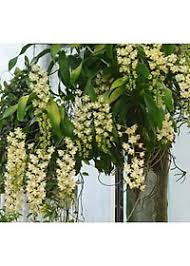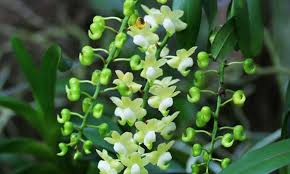
Da Châu orchids (*Rhynchostylis gigantea*) are beloved for their stunning flowers and unique growth habits. These orchids are not only a beautiful addition to any collection but also require proper care to thrive. One of the most critical aspects of orchid care is repotting and creating a suitable living environment that fosters healthy growth. In this comprehensive guide, we will delve into the intricacies of repotting Da Châu orchids and revitalizing their living conditions, ensuring they flourish and bloom beautifully.
## Table of Contents
1. **Understanding Da Châu Orchids**
– 1.1 Botanical Classification
– 1.2 Native Habitat and Growth Conditions
2. **Signs That Your Da Châu Orchid Needs Repotting**
– 2.1 Root Health
– 2.2 Potting Medium Degradation
– 2.3 Overcrowding
3. **Choosing the Right Pot for Your Da Châu Orchid**
– 3.1 Pot Material
– 3.2 Pot Size
– 3.3 Drainage Considerations
4. **Selecting the Ideal Potting Medium**
– 4.1 Types of Potting Medium
– 4.2 Mixing Your Own Medium
5. **Step-by-Step Guide to Repotting Da Châu Orchids**
– 5.1 Preparation
– 5.2 Removal from the Old Pot
– 5.3 Inspecting and Pruning Roots
– 5.4 Repotting Process
– 5.5 Watering and Care After Repotting
6. **Revitalizing the Living Environment**
– 6.1 Light Requirements
– 6.2 Humidity and Airflow
– 6.3 Temperature Preferences
– 6.4 Fertilization Guidelines
7. **Common Mistakes to Avoid When Repotting**
8. **Conclusion**
9. **Additional Resources**
## 1. Understanding Da Châu Orchids
### 1.1 Botanical Classification
Da Châu orchids, known scientifically as *Rhynchostylis gigantea*, belong to the Orchidaceae family. They are known for their striking, fragrant flowers and are commonly found in various colors, including white, pink, and purple. Understanding their classification helps in appreciating their unique characteristics and care requirements.
### 1.2 Native Habitat and Growth Conditions
Da Châu orchids are native to the tropical forests of Southeast Asia, particularly in regions like Thailand and Vietnam. In their natural habitat, they thrive on trees, utilizing their epiphytic nature to absorb moisture and nutrients from the air. These orchids prefer bright, indirect light and high humidity, mimicking the conditions of their native environment.
## 2. Signs That Your Da Châu Orchid Needs Repotting
### 2.1 Root Health
One of the first signs that your Da Châu orchid needs repotting is the condition of its roots. Healthy roots are typically green or white, firm to the touch, and well-distributed throughout the pot. If you notice the following issues, it’s time to consider repotting:
– **Dark or mushy roots:** These indicate root rot, often due to overwatering or poor drainage.
– **Root-bound:** If the roots are circling around the bottom of the pot or protruding from the drainage holes, it’s a sign that the plant needs more space.
### 2.2 Potting Medium Degradation
Over time, the potting medium can break down, losing its ability to provide adequate aeration and drainage. If you notice:
– **Compacted medium:** The potting mix has become dense and hard, preventing water and air from reaching the roots.
– **Foul odor:** A strong smell may indicate decay in the potting medium, necessitating repotting.
### 2.3 Overcrowding
If your Da Châu orchid has outgrown its pot or if multiple plants are crowded together, repotting is essential to provide sufficient space for growth. Overcrowded conditions can lead to poor air circulation and increased competition for nutrients.
## 3. Choosing the Right Pot for Your Da Châu Orchid
### 3.1 Pot Material
When selecting a pot for your Da Châu orchid, consider the following materials:
– **Plastic pots:** Lightweight and retain moisture well, making them a popular choice for orchids. However, they may not provide as much aeration as clay pots.
– **Clay pots:** Provide excellent drainage and aeration but can dry out quickly, requiring more frequent watering.
### 3.2 Pot Size
Choose a pot that is only slightly larger than the previous one. A pot that is too large can retain excess moisture, leading to root rot. Generally, select a pot that allows for about one inch of space around the roots.
### 3.3 Drainage Considerations
Good drainage is crucial for orchid health. Ensure the pot has sufficient drainage holes to prevent water from accumulating at the bottom. You may also consider pots designed specifically for orchids, which often feature extra drainage openings.
## 4. Selecting the Ideal Potting Medium
### 4.1 Types of Potting Medium
Da Châu orchids thrive in well-draining potting media that provide adequate aeration. Some suitable options include:
– **Bark chips:** Medium to large-sized pieces of pine bark are excellent for orchid potting mixes, offering good drainage and aeration.
– **Coconut coir:** A sustainable option that retains moisture while allowing for airflow.
– **Sphagnum moss:** Often used in conjunction with bark, it provides moisture retention without suffocating the roots.
### 4.2 Mixing Your Own Medium
For optimal growth, consider mixing your own potting medium. A suggested blend for Da Châu orchids is:
– 50% pine bark chips
– 30% coconut coir
– 20% sphagnum moss
This combination ensures adequate drainage, moisture retention, and aeration for healthy root development.
## 5. Step-by-Step Guide to Repotting Da Châu Orchids
### 5.1 Preparation
Before you begin the repotting process, gather the following materials:
– New pot (slightly larger than the current one)
– Fresh potting medium
– Clean scissors or pruning shears
– Water for soaking roots
– Sterilizing solution (e.g., rubbing alcohol) to clean tools
### 5.2 Removal from the Old Pot
1. **Gently remove the orchid from its current pot:** Turn the pot upside down, tapping the bottom gently to release the plant. If the roots are stuck, carefully squeeze the pot to loosen them.
### 5.3 Inspecting and Pruning Roots
1. **Examine the roots:** Inspect the root system for any signs of rot or damage. Healthy roots should be firm and white or green.
2. **Prune damaged roots:** Using sterilized scissors, trim away any dark, mushy, or dead roots. This promotes healthy growth and prevents disease.
### 5.4 Repotting Process
1. **Prepare the new pot:** Place a layer of the potting medium at the bottom of the new pot.
2. **Position the orchid:** Place the orchid in the center of the pot, ensuring that the base of the plant sits at the same level as it did in the previous pot.
3. **Add potting medium:** Gradually fill the pot with the new potting medium, gently pressing it down to eliminate air pockets while avoiding excessive pressure on the roots.
### 5.5 Watering and Care After Repotting
1. **Water the plant:** After repotting, water the orchid thoroughly until excess water drains from the bottom. This helps settle the medium around the roots.
2. **Place in a suitable location:** Position the repotted orchid in a location with bright, indirect light to encourage recovery.
3. **Monitor humidity:** Ensure the humidity levels are maintained between 50-70% for optimal growth.
## 6. Revitalizing the Living Environment
Creating an optimal living environment for your Da Châu orchid is essential for its long-term health and blooming potential. Here are key factors to consider:
### 6.1 Light Requirements
Da Châu orchids thrive in bright, indirect light. Placing them near a window with filtered sunlight or using sheer curtains can provide the right balance of light. Avoid direct sunlight, as it can scorch the leaves.
### 6.2 Humidity and Airflow
High humidity is crucial for Da Châu orchids. Aim for humidity levels of 50-70%. To maintain humidity, consider the following methods:
– **Misting:** Lightly mist the leaves regularly, especially during dry seasons.
– **Humidity trays:** Place the orchid pot on a tray filled with water and pebbles to increase ambient humidity without waterlogging the roots.
### 6.3 Temperature Preferences
Da Châu orchids prefer temperatures between 20-30°C (68-86°F) during the day and slightly cooler temperatures at night. Avoid exposing them to extreme temperature fluctuations, as this can stress the plant.
### 6.4 Fertilization Guidelines
Regular fertilization is essential for healthy growth. Use a balanced orchid fertilizer (e.g., 30-10-10) diluted to half strength during the growing season (spring and summer). Fertilize every 2-4 weeks, and reduce feeding during the dormant winter months.
## 7. Common Mistakes to Avoid When Repotting
1. **Repotting too frequently:** While it’s essential to repot when necessary, doing so too often can stress the plant. Repot every 1-2 years or when signs indicate it’s needed.
2. **Using the wrong potting medium:** Ensure you
use a well-draining medium that allows for aeration. Avoid regular potting soil, as it can suffocate the roots.
3. **Neglecting root health:** Always inspect and prune the roots before repotting to promote healthy growth.
## 8. Conclusion
Repotting and revitalizing the living environment for Da Châu orchids is crucial for their health and longevity. By following the steps outlined in this guide, you can ensure that your orchids thrive and produce stunning blooms year after year. Remember to monitor their growth, provide the right conditions, and be attentive to their needs. With proper care, your Da Châu orchids will flourish, bringing beauty and joy to your home.
## 9. Additional Resources
For further reading on Da Châu orchids and their care, consider exploring the following resources:
– **Books on Orchid Care:** Titles such as “The Orchid Whisperer” by Bruce Rogers offer in-depth knowledge about various orchid species.
– **Online Communities:** Join online forums and social media groups dedicated to orchid enthusiasts for tips and support.
– **Local Orchid Societies:** Many regions have local orchid societies that provide workshops, resources, and a community of fellow orchid lovers.
By educating yourself and staying engaged with the orchid community, you can continue to learn and enhance your skills in caring for Da Châu orchids and other varieties. Happy gardening!


